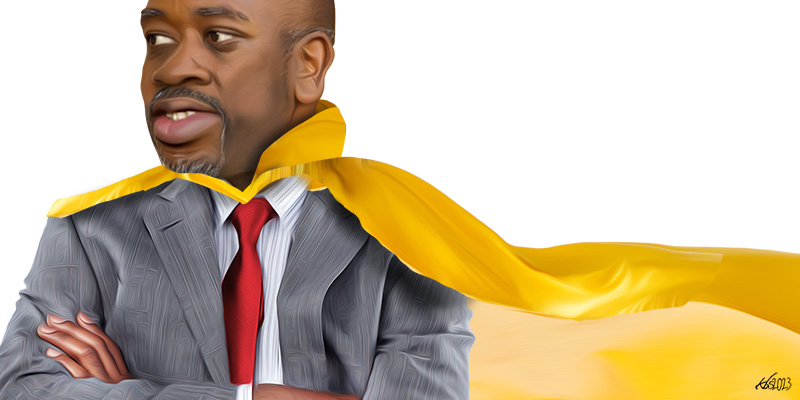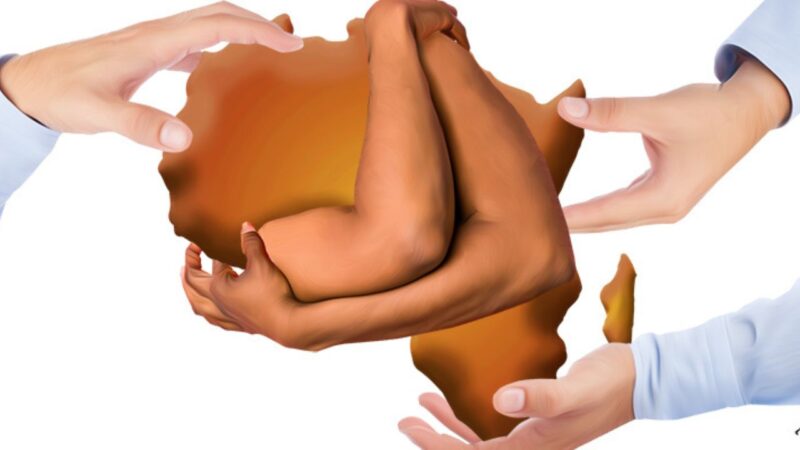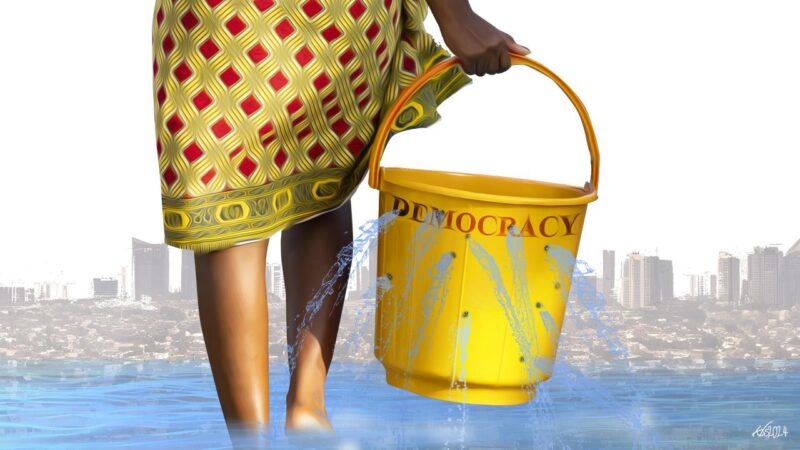On the 26th of February 2022, Zimbabwe’s Vice President delivered a chilling threat to the opposition. In a speech the “retired” army general Constantino Chiwenga, the chief architect of the November of 2017 putsch that removed Robert Mugabe, threatened that the opposition will be “crushed and ground on a rock like lice”. The General claimed that the ruling party was a “Goliath”; the Biblical imagery of the diminutive David “slaying” the giant Goliath was entirely lost on the Vice President. Here are his words:
“Down with CCC. You see when you crush lice with a rock, you put it on a flat stone and then you grind it to the extent that even flies will not eat it… But we are as big as Goliath we will see it [the opposition] when the time comes”.
The following day violent mayhem broke out in Kwekwe, the very town where the fiery speech was made. By the time the chaos ended, the opposition reported that 16 of their supporters had been hospitalised and it was recorded that a young man was sadistically speared to death. The supporters of the ruling party had taken the threat to “crush” and “grind” the opposition seriously. Details emerged—from the police—that the suspects were from the ruling party and had tried to hide in a property owned by a former minister of intelligence.
The launch of the Citizens Coalition for Change (CCC) has galvanised the opposition. Going by the youthful excitement at the rallies, the violence flaring against its supporters, and the way the police has been clamping down on CCC rallies, the ruling elites have realised they face a serious political threat from what has been called the “yellow” movement.
Exit Mugabe and Tsvangirai: Shifts in opposition and ruling class politics
The death of opposition leader and former prime minister Morgan Tsvangirai in February 2018 came in the wake of the November 2017 coup and other significant political events that followed. The death was a big blow to the opposition; there had been no succession planning, which was rendered more complex by the existence of three vice presidents deputising Tsvangirai. The MDC Alliance succession debacle set in motion a tumultuous contest that splintered the opposition. Court applications followed, and the ruling elites took an active interest. When the court battles ended, the judiciary ensured a “win” for the faction favoured by the ruling class. That faction was formally recognised in parliament, given party assets and provided with financial resources by the Treasury that were meant for the opposition.
As for the ruling party, there has been a shift in the political contests along factional lines, accentuated following the death of Robert Gabriel Mugabe in September of 2019. There is high suspicion that the 2017 coup plotters (generals and commanders) now want their proverbial “pound of flesh”—the presidency. With the presidency as the bull fighter’s prize, the factions are now lining up either behind the president or the behind generals and this is cascading through the ruling party structures. The historical faction known as G40 (Generation 40) that hovered around the then first lady has been practically shut out of political power, with its anchors remaining holed up outside the country. Remnants of the G40 faction in Zimbabwe have been side-lined, with some of them subjected to the endless grind of court processes to ensure they keep their heads down.
Yet another element has emerged, that of a president who feels besieged and is re-building the party and executive positions in the image of his regional ethnic block, bringing into the matrix a potent powder keg waiting to explode in the future.
The ruling party has gone further to entice Morgan Tsvangirai’s political orphans in order to decimate the leadership ranks of the opposition. Patronage is generously dished out: an ambassadorial appointment here, a gender commissioner position there, a seat on the board of a state parastatal…, and so on. These appointments come with extreme state largesse—cars, drivers, state security, free fuel, housing, pensions and the list goes on. The patronage also includes lucrative gold mining claims and farms running into hundreds of acres that come with free agricultural inputs. The former opposition stalwarts must be “re-habilitated” by being taught “patriotism” at a Bolshevik-like ideological school and then paraded at rallies as defectors to ZANU-PF.
Yet another element has emerged, that of a president who feels besieged and is re-building the party and executive positions in the image of his regional ethnic block.
As these political shifts take place and the opposition divorces itself from the succession mess, there are also changes in Zimbabwe’s economy and this has a direct impact on the trajectory of politics in the country.
Transformed political economy: Informality, diaspora and agrarian change
From about the end of the 1990s and stretching into the subsequent two decades up to 2022, Zimbabwe’s political economy has shifted significantly. Firstly, the fast-track land reform of the early 2000s altered land ownership from white settler “commercial” farmers to include more black people. The white-settler class power was removed as a factor in politics and in its place is a very unstable system of tenure for thousands of black farmers that have been married to the state for tenure security and stability.
Secondly, the follow-on effect of the land reform meant that Zimbabwe’s industrial base was altered, and this has resulted in a highly informalized economy or what others have called the “rubble”. An informal economy is now the new normal across the board for ordinary citizens and this has weakened organized labour as a voice in political contests. In 2020, the World Bank estimated extreme poverty at 49 per cent; this is infusing a sense of urgency for political change and is putting pressure on the political elites in Harare.
Thirdly, the exodus of Zimbabwe’s younger population into the diaspora has introduced another factor into the political matrix. According to official figures, the diaspora transferred about US$1.4 billion in 2021 alone, but this figure doesn’t capture remittances that are moved into Zimbabwe informally; the figure is much higher. The diaspora has actually used its cash to have a political voice, often via the opposition or independent “citizen initiatives”. It is proving to be a significant player in the political matrix to the extent that Nelson Chamisa has appointed a Secretary for Diaspora Affairs. For its part, the ruling party has blocked the diaspora vote.
Fourth, the national political economy has been “captured” by an unproductive crony class to the extent that researchers have estimated that as much as half of Zimbabwe’s GDP is being pilfered:
“It is estimated that Zimbabwe may lose up to half the value of its annual GDP of $21.4bn due to corrupt economic activity that, even if not directly the work of the cartels featured in the report, is the result of their suffocation of honest economic activity through collusion, price fixing and monopolies. Ironically, President Emmerson Mnangagwa, who has been a public critic of illicit financial transfers, is identified by the report as one of the cartel bosses whose patronage and protection keeps cartels operating.”
Fifthly, and often under-researched, is the substantial role of China across Zimbabwe’s political economy as Harare’s political elites have shifted to Beijing for a closer alliance. This has paid handsomely for China which has almost unrestrained access to Zimbabwe’s natural resources, and the political elites are “comrades in business” with—mostly—Chinese state corporations; China’s influence is pervasive and evident across the country. Put together, the factors above mean that the political economy structure has changed significantly and it is within this landscape that the Citizens Coalition for Change—dubbed the “yellow movement” — that has been launched by the opposition will have to operate and organise.
‘Yellow Movement’: Re-articulating the future beyond the ‘Harare Bubble’?
Since its launch, the opposition movement has swept into the CCC’s ranks the younger demographic of activists together with some solid veterans who survived the brutal years of Robert Mugabe’s terror. Zimbabwe’s median age is reported to be about 18 years of age; if these young people can register, turn out to vote and defend their vote, there is a whirlwind coming for the old nationalists in Harare.
Some within the ruling party have noticed this reality, with a former minister and ruling party member stating that “Nelson Chamisa is gaining popularity because the ZANU PF old guard is fighting its own young men and women”. This admission is consistent with the words of Temba Mliswa, another “independent” member of parliament and a former leading activist in the ruling party, who stated that:
“The generational approach is like you trying to stop a wave of water with your open hands. You cannot ignore it. It’s a generational issue. You cannot ignore it. You need to look at it. You need to study it… There is no young person in ZANU PF who is as vibrant as Chamisa, who is as charismatic as Nelson Chamisa. Chamisa is going to go straight for ED (President Emmerson Mnangagwa)… There is no gate preventing this.’
These admissions are an indication that the CCC movement poses a serious threat to the ruling party. But beyond the contest of politics, of ideas, of policy platforms, the “yellow movement” will have to divorce itself from the “Harare Bubble”. The ruling nationalists polished a rigid centralised political system inherited from settler-colonialism, and have used this to build a crony network of robbery based in the capital city while impoverishing other regions. But they are not alone in this; even the opposition has often overlooked the fact that “all politics is local” and it has also created a “Harare Bubble” of yesterday’s heroes and gatekeepers who, armed with undynamic analyses, continue to cast their shadows into the arena long after their expiry date.
“Nelson Chamisa is gaining popularity because the ZANU PF old guard is fighting its own young men and women”.
The yellow movement will have to go local and divorce itself from the parochial legacy of previously progressive platforms that have now been cornered by an elite who have become careerist, corrupt, inward-looking and, like civil warlords, only loyal to imported 10-year-old whisky bottles and their kitambis—their visibly ballooning stomachs.
Yet there is no ignoring it; Zimbabwe’s youth have been emboldened by political change in Zambia and Malawi, and by the rise of younger leaders in South Africa. The winds are blowing heavily against the status quo. In the 2023 general election, the ruling nationalists will face a more tactful, daring and politically solid Nelson Chamisa who has strategically pushed back against “elite pacts”. Added to his eloquence, his speeches are getting more structured, substantially more polished, and he is projecting the CCC movement as a capable alternative government. With the indelible footprints of Morgan Tsvangirai in the background, the next general election, in 2023, will be an existential contest for Harare’s old nationalists—they are facing their Waterloo.








